|
MONITORAPP Overseas Department Simon Kwon From 1995, when the establishment of the internet infrastructure system was booming around the world, the infrastructure environment has changed rapidly. Many IT infrastructures are being transferred to cloud network environments, and the demand for SaaS is increasing. This article will introduce the environmental change of IT infrastructure and how to use SaaS in the cloud.
-Contents-
|
- Introduction
Since the beginning of the internet service boom, in 1995, the internet service market has been expanding gradually. Even until the recent past, enterprises had to construct their own servers and systems to go along with it to provide web services or file storage services to the users. In order to provide an IT infrastructure for an office, it was necessary to purchase server and network products, security equipment/software, etc., and consider the staff and companies responsible for maintaining and managing them. To provide IT services, investing a significant amount of time and money no longer became an option but a must for enterprises. However, this paradigm is shifting.
- The flow of network system environment
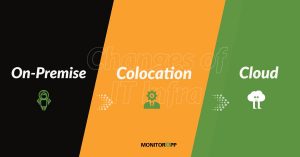
2.1. On-Premise
The typical network system environment people think of is an on-premise environment. On-premise is a network and related products, which service provider has built themselves, to provide services. This requires physical products to construct. This method also requires too much time and resources and before a new environment was introduced, this has been the biggest obstacle in IT infrastructure. Building an on-premise environment does not take mere weeks but months to set up properly. From the start to the so-called “stabilization period”, it is necessary to consider various elements such as the design of the environment, design plan, product selection, purchase, operation plan, and selection of the person in charge or company to operate it. It may even take up to several years.
2.2. Colocation
To mitigate these obstacles, companies with data centers started to offer colocation services. Colocation is service provided by data centers that construct an on-premise IT infrastructure as well as management for a fee. The fee includes line usages, server, and monitoring costs (this might differ by the data center but it is common to have one bill for all-inclusive services). This method is more convenient and does not require manpower for management compared to building your own server room, so colocation has been a preferred method used by companies that provide IT services.
Although colocation does not require maintenance costs, it might still be costly. Colocation companies provide 24-hour maintenance service so after the initial set-up colocation might be more costly than setting up one’s own server.
An on-premise environment can also lead to wasted resources. For example, if your set-up is constructed to handle 1,000,000 users but recently the number of users has dwindled to 100, then you are using an environment way to big for your needs. Due to the characteristics of the on-premise environment, it is difficult to scale up as the demand goes up as well.
2.3. Cloud
To deal with the issues described above, the cloud network was born.
Cloud, a word often thrown around when talking about the fourth industrial revolution or IT in general, is no longer a choice. To make it easier to understand the cloud, just remember that the system is operating in a virtualized form. In the past, it was operated on 1 OS to 1 CPU(1:1 ratio) but now it is operating on 1 CPU and an n number of OS’s (1:n ratio). Thus multiple OS can share one computer’s resources.
Data centers hold numerous servers that can install multiple OS’s or software for various purposes, and provide clients with some of the resources of the servers. Sharing resources have become a method of solving one of the many issues of on-premise or colocation architecture.
Cloud infrastructure does not require physical servers nor do they require maintenance by the individual. Similar to colocation, cloud provider maintains physical servers, which ensures that you do not need to worry about upkeep. Depending on the system architecture, the same server and security products can be run virtually on the cloud, so the same level of service as the traditional infrastructure can be provided with software control and management. Rapid and drastic traffic changes or system usage can be easily managed by creating or eliminating virtual systems. Such technology is called auto-scaling and this technique is derived from load balancing so similar to handling traffic load, resources can be increased or decreased.
- Recent network environment trends and the cloud
The current network environment is changing rapidly. As mentioned above the cloud network, which solves many problems posed by on-premise architecture, the market is expanding consistently while the on-premise market decreases.
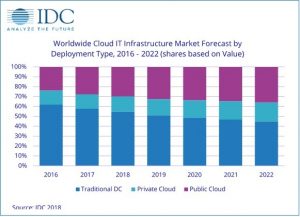
[1]IDC Market Prediction
3.1. Uses of cloud
Most cloud environment uses a public cloud. Notable public cloud providers are AWS, MS Azure, Alibaba, and Google. If one has to modify and install a network system and maintain the software per all these different cloud providers then cloud infrastructure becomes just as complicated as an on-premise environment. For this reason, public cloud providers help sell and purchase SaaS (Software as a Service). I will give the AWS marketplace as an example.
3.2. Advantages of the AWS marketplace and its features
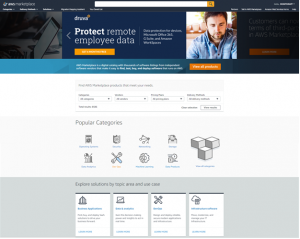
[2]AWS Marketplace
In the AWS marketplace, pre-configured software can be quickly launched with just a few clicks, with the option of software solutions like AMI (Amazon Machine Image), SaaS (Software as a Service), and more.[3] Hence, the cloud allows you to instantly purchase and use products (server, security products, etc.). It even provides storage and data analysis system for machine learning-based system for research. Such services are not only provided by AWS but also various vendors so you can make purchase products that suit your needs. In the past, product evaluation and comparison by an engineer were necessary, but now just by a few clicks, you can buy specific functions you need. Things have become much more streamlined. As a product, you can select server specifications, OS, and environment, not just security or network.
There are a wide variety of products in the marketplace, and it provides various products from countless vendors. MONITORAPP’s products are also registered in the marketplace.
- How to Use a Security Product on AWS Marketplace
Let’s assume you are using MONITORAPP’s AIWAF-VE from AWS Marketplace. The necessary steps are as follows.
- Search for “MONITORAPP” or “AIWAF” on AWS Marketplace.
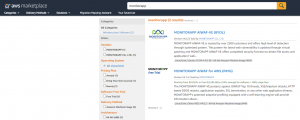
- Check the product description, highlights, and type.
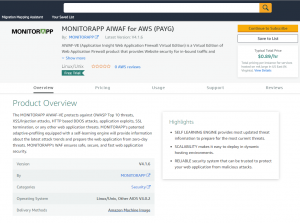
- Check the pricing information and pick which region and spec you are going to use.
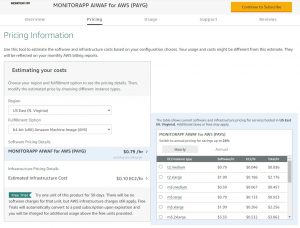
- Finally, click the “Continue to Launch” button to use the product.
MONITORAPP’s AIWAF-VE PAYG offers 1 month Free Trial service if you want to protect your web server with MONITORAPP’s high-performance, high-spec, secure, fast-deployed, with undisrupted web firewall service in the form of a hybrid cloud.


